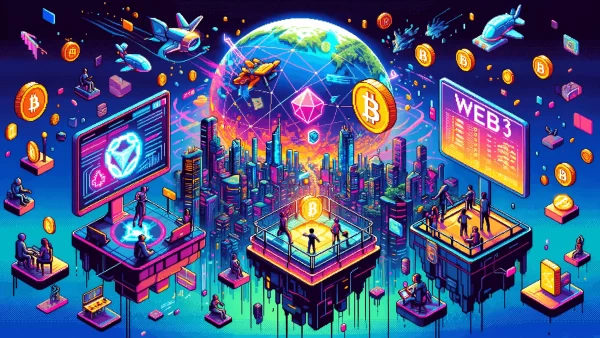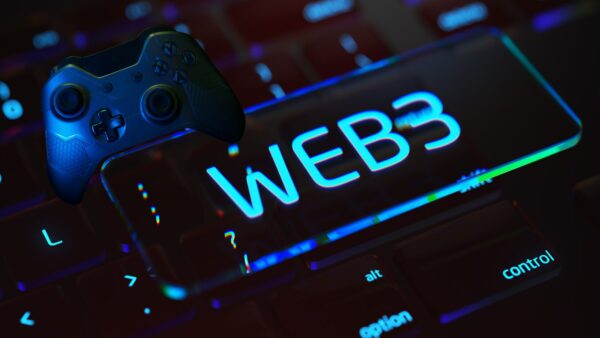Web3 Gaming: The Dawn of a New Digital Gaming Era
Web3 gaming is reshaping the digital world, offering more than just entertainment; it’s introducing new concepts of ownership, economic opportunity, and community-driven development. Unlike traditional gaming, where players are limited by the constraints of a centralized system, Web3 allows for decentralized ownership of assets, meaning gamers can own, trade, and profit from their digital creations. By harnessing blockchain technology, Web3 gaming presents a future where players have greater autonomy, unlocking a world where in-game items carry real-world value and gaming experiences become more interactive and immersive.
A Deep Dive into Web3 Gaming: How Does It Differ?
The key innovation behind Web3 gaming is the integration of blockchain, a decentralized ledger that secures and verifies the ownership of in-game assets. Traditionally, gaming companies have controlled every aspect of the experience, from the in-game economy to the content players can access. When you purchase items in a traditional game—whether it’s a new weapon, skin, or character—you don’t actually own it; the game’s servers do. If the game is shut down, your purchased items disappear.
Web3 changes this paradigm entirely. Through the use of NFTs (non-fungible tokens) and cryptocurrency, players can actually own the items they acquire. NFTs represent unique, provably scarce digital assets that belong to the player, not the game developer. This means the rare sword you unlocked in one game can be yours to keep, sell, or trade, even outside of the game’s ecosystem. Blockchain ensures that these digital assets are secure and traceable, allowing players to move beyond the confines of a single game or platform.
Additionally, Web3 gaming allows players to transfer their assets between different games that support the same blockchain standards, enabling a fluid and connected digital experience. This opens up entirely new opportunities for gamers to build, trade, and enhance their virtual possessions while moving between different gaming worlds.
The P2E model has led to the emergence of entirely new gaming economies, where players can create sustainable income streams. For example, games like Axie Infinity have shown that players in certain regions can generate significant income through gaming, even replacing traditional jobs in some cases. This economic empowerment is particularly impactful in regions where access to financial opportunities might be limited, giving Web3 gaming the potential to become a tool for global economic inclusion.
In addition to offering economic incentives for individual players, the P2E model also benefits game developers by creating a more engaged and active player base. As players have real financial stakes in the game, they are more likely to invest time and effort, contributing to a thriving in-game economy.

True Ownership and Interoperability: Breaking Down Game Walls
A defining feature of Web3 gaming is the concept of true digital ownership. In traditional gaming, players can spend hundreds, if not thousands, of dollars on in-game items, only to find that these items have no value or utility outside of that specific game. Once the game is no longer supported or relevant, those purchases essentially vanish, leaving players with nothing to show for their investment.
Web3’s NFT-driven economy solves this problem by granting players full ownership of their in-game assets. These assets exist on the blockchain, independent of any single game developer, meaning players can keep, sell, or trade their digital possessions even after the game has ended. Additionally, because Web3 games are built on open blockchain protocols, these assets can be used across different games and platforms. This level of interoperability allows players to carry their items and identities with them, weaving together their gaming experience into a more cohesive, interconnected virtual life.
For example, imagine you acquire a rare character in one game. In Web3 gaming, you can then take that character into another game, using it in a completely different environment. The same applies to virtual land, weapons, or any other digital asset. This creates a seamless flow between games, adding layers of personalization and flexibility that were previously impossible.
Decentralized Governance: Giving Power Back to Players
Web3 gaming also introduces decentralized governance through the use of DAOs (Decentralized Autonomous Organizations), which give players a voice in shaping the future of the games they love. Traditional games operate under a top-down management style, where developers make all decisions regarding updates, game mechanics, and future developments. Players, while essential to the game’s success, have little to no say in how the game evolves.
With Web3 gaming, players can participate in decentralized governance by holding tokens that allow them to vote on critical decisions about the game’s direction. From new features and content to balancing gameplay mechanics, players can influence the development process. This democratization of game management fosters a stronger bond between developers and the community, ensuring that the game evolves in a way that reflects the desires of its most active users.
DAOs not only give players a seat at the table but also encourage transparency in decision-making. By participating in governance, players gain a sense of ownership over the game’s trajectory, creating a more engaging and collaborative gaming experience.
Challenges Facing Web3 Gaming:
Despite the enormous potential of Web3 gaming, several significant challenges must be addressed for it to reach mainstream adoption. One of the biggest obstacles is scalability. Many blockchain networks currently struggle to handle the volume of transactions necessary to support large-scale gaming ecosystems. Slow transaction speeds and high gas fees can disrupt the gaming experience, making it less appealing for users.
Ethereum, the most popular blockchain for NFTs and Web3 applications, is notorious for its scalability issues. However, solutions like Ethereum 2.0 and layer-two networks such as Polygon are being developed to improve transaction speed and reduce costs, making Web3 gaming more accessible to a larger audience.
The energy consumption required to maintain certain blockchain networks, particularly proof-of-work chains like Bitcoin, has raised alarms about the sustainability of Web3 applications. However, many developers are shifting to more eco-friendly options, such as proof-of-stake chains like Solana or upcoming Ethereum upgrades, which are far less energy-intensive.
Additionally, mass adoption of Web3 gaming will require a steep learning curve for both players and developers. The integration of blockchain concepts like NFTs, decentralized finance (DeFi), and smart contracts can be intimidating for those unfamiliar with the technology. For Web3 gaming to truly take off, user-friendly interfaces and educational resources will be essential to bridge the gap between the existing gaming community and the new decentralized gaming ecosystem.
Web3 gaming is more than just the next phase of interactive entertainment—it’s the foundation for a new kind of digital society. With its ability to empower players, create new economic opportunities, and foster global connections, Web3 gaming is poised to revolutionize not just how we play, but how we live in virtual spaces.
As these technologies evolve, the potential for innovation is limitless. In the years to come, Web3 gaming could redefine the entire gaming industry, moving us toward a more decentralized, player-focused world where everyone can contribute to and benefit from the digital experiences they love.
FAQs:
1. What is Web3 gaming?
Web3 gaming marks a revolutionary shift in the gaming world by incorporating blockchain technology. This new model gives players true ownership of their digital assets, such as characters, items, and currency, through decentralized networks. Unlike traditional games, where assets are controlled by developers, Web3 gaming allows players to trade, sell, or earn from their in-game possessions.
2. How does Web3 gaming differ from traditional gaming?
In traditional gaming, assets like skins and characters are owned by the game’s servers, meaning players have no control over them outside of the game. Web3 gaming, on the other hand, utilizes blockchain to grant players real ownership of their assets. This enables players to transfer, sell, or use these assets across various games, breaking the boundaries of a single game’s ecosystem.
3. What role do NFTs play in Web3 gaming?
NFTs (non-fungible tokens) are digital certificates of ownership that are stored on the blockchain. In Web3 gaming, NFTs represent unique in-game items such as rare skins, characters, or virtual land. These tokens provide players with undeniable proof of ownership, which they can then trade or sell in decentralized marketplaces.
4. What is the Play-to-Earn (P2E) system?
The Play-to-Earn (P2E) system is a groundbreaking feature of Web3 gaming that allows players to earn real-world value through gameplay. Players receive cryptocurrency, tokens, or NFTs as rewards for their in-game achievements, which can be traded or sold. This model transforms gaming from a leisure activity into a potential source of income.
5. How does blockchain technology ensure asset ownership in Web3 games?
Blockchain technology ensures asset ownership by recording each transaction on a decentralized ledger. This ledger is immutable and transparent, meaning once an asset is acquired, its ownership is permanently recorded on the blockchain. This gives players absolute control over their digital assets, independent of the game’s developers.
6. What is asset interoperability in Web3 gaming?
Asset interoperability refers to the ability to use in-game items across multiple games or platforms. Thanks to blockchain technology, Web3 gaming allows players to move their NFTs and other assets seamlessly between different gaming environments. This means that an item or character you acquire in one game can be utilized in another, enhancing the overall gaming experience.
7. What is a DAO and how does it impact Web3 gaming?
A DAO (Decentralized Autonomous Organization) is a form of governance that enables players to influence the development of a game. By participating in a DAO, players can vote on crucial decisions such as game updates and feature additions. This approach decentralizes control and ensures that the gaming community has a voice in shaping their gaming experience.
8. Are Web3 games environmentally sustainable?
The environmental impact of Web3 games depends on the blockchain they use. Some blockchains, particularly those relying on proof-of-work, are energy-intensive. However, many Web3 games are adopting more sustainable blockchains, like those using proof-of-stake or other eco-friendly methods, to reduce their carbon footprint.
9. What are the main challenges of Web3 gaming?
Key challenges in Web3 gaming include scalability issues, where blockchain networks may experience slow transaction times and high fees. Environmental concerns about blockchain energy use are also prevalent, though more sustainable solutions are being developed. Additionally, there is a need for greater player education to ease the transition into this new gaming paradigm.
10. How can I get involved in Web3 gaming?
To dive into Web3 gaming, you’ll first need a digital wallet, such as MetaMask, to manage your NFTs and cryptocurrencies. Once set up, you can explore Web3 games by connecting your wallet and acquiring NFTs or tokens. Each game offers unique features and economies, so it’s beneficial to research and understand the specific game mechanics before getting started.
11. Can Web3 gaming be a source of income?
Yes, Web3 gaming offers potential income opportunities through the Play-to-Earn model. By earning and trading NFTs or cryptocurrency, players can convert their in-game achievements into real-world earnings. This model allows gamers to potentially generate income from their gaming activities, adding a financial dimension to their hobby.
12. Are Web3 games secure to play?
Web3 games are generally secure due to the decentralized nature of blockchain technology, which makes data tampering difficult. However, players should exercise caution and use reputable wallets and platforms to protect against potential scams or vulnerabilities in less-established games.
13. What are some popular Web3 games right now?
Several Web3 games have gained popularity, including Axie Infinity, Decentraland, The Sandbox, and Gods Unchained. These games have made waves with their innovative approaches to Play-to-Earn systems and blockchain integration, attracting a growing player base.
14. How does decentralized governance enhance Web3 gaming?
Decentralized governance through DAOs allows players to have a direct influence on the game’s development. By holding governance tokens, players can vote on decisions regarding updates, features, and game policies, ensuring that the game evolves in ways that reflect the community’s interests and desires.
15. Will Web3 gaming replace traditional gaming?
While Web3 gaming introduces exciting new possibilities, it is unlikely to completely replace traditional gaming. Instead, Web3 gaming will complement existing models, offering new opportunities for ownership, earning, and community engagement. Both traditional and Web3 gaming will coexist, each appealing to different preferences and interests in the gaming world.




